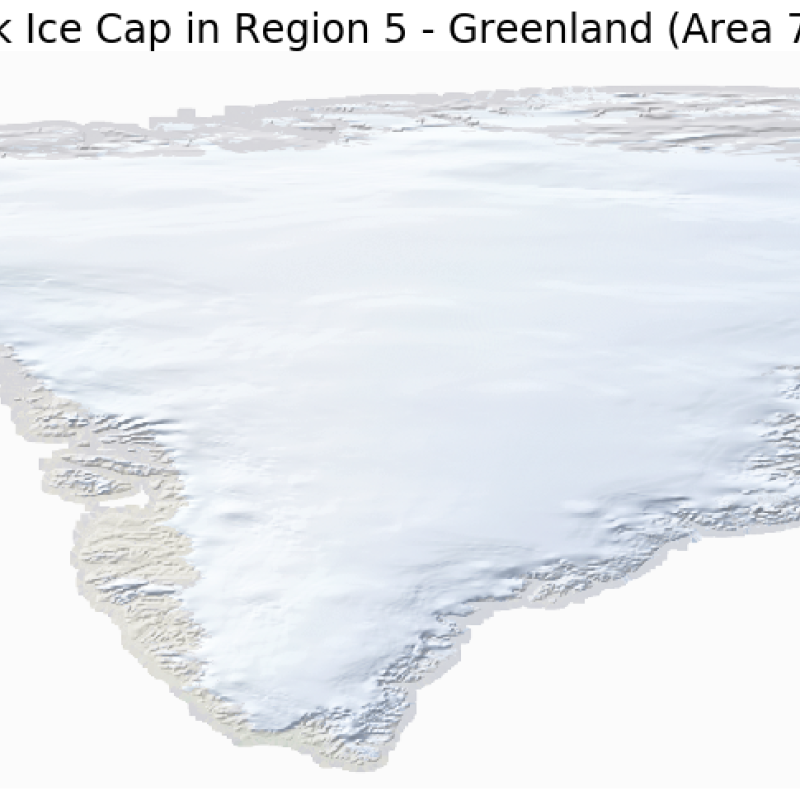First Look at the Global Glacier Landscape
Provided by a Mashup of Glacier Inventories
Why a First Global Look?
It's important to study glaciers because not only are glaciers a beautiful part of our landscape that are disappearing but in many parts of the world glaciers are a source of freshwater and energy through the use of the melt water. As these glaciers retreat, these nations will be out of water or need to find alternative forms of energy. Studying glaciers helps to inform our knowledge of climate change and helps water and energy resource managers plan for the future.
The world’s glaciers are grouped into 19 regions. Researchers have performed many regional studies of glaciers; however, global studies are scarce. Therefore, I am doing a global assessment of glaciers and glacial retreat to further our knowledge of these important natural resources on a worldwide scale.

While also wanting to know what the largest glaciers are in the world, I'm also interested in what are the largest glaciers in each of the glacier regions. The regions help to organize the data on glaciers. It is helpful to know where the largest glaciers by geographic region. Depending on the region you are looking at, the glaciers can have different characteristics and sizes. For example, glaciers on the Greenland and Antarctic Ice Caps are quite large due to their locations at the North and South Poles, respectively, and the amount of ice surrounding them. Alpine glaciers, on the other hand, like those that reside in the mountains of Europe, are relatively quite small. The glaciers in each of the regions tells a specific story about the climate change happening in those differing regions.
I'm doing this project in conjunction with the World Glacier Monitoring Service located at the University of Zurich. The WGMS compiles and disseminates standardized data on glacier fluctuations.
import scripts.wgms_scripts as ws
import os
import os.path as op
import sys
import pandas as pd
import matplotlib.pyplot as plt
import geopandas as gpd
from shapely.geometry import polygon
import rasterio as rio
from rasterio.plot import plotting_extent
import earthpy.spatial as es
import warnings
warnings.filterwarnings("ignore")# set working dir
HOME = op.join(op.expanduser("~"))
os.chdir(os.path.join(HOME, "git/wgms-glacier-project"))module_path = os.path.abspath(os.path.join('..'))
if module_path not in sys.path:
sys.path.append(module_path)
What are the 19 glacier regions?
The Global Terrestrial Network for Glaciers (GTN-G) has defined 19 glacier regions worldwide. A map of these regions plus a list of their names is shown below.
# Open world map
world_bound_fp = 'data/ne_110m_land/ne_110m_land.shp'
world_bound = gpd.read_file(world_bound_fp)# Open glacier regions
glacier_regions_fp = "data/gtn-g-glacier-regions/cleaned/GTN-G_glacier_regions_201707_cleaned.shp"
glacier_regions = gpd.read_file(glacier_regions_fp)# Plot the the 19 regions each with their own color
fig, ax = plt.subplots(figsize=(15, 10))
world_bound.plot(ax=ax, color="darkseagreen")
glacier_regions.boundary.plot(ax=ax, color="black")
for x in range(0, 19):
point = glacier_regions[x:x+1].centroid
plt.text(point.x[x], point.y[x], str(x+1), fontsize=14)ax.set_title('World map with the 19 glacier regions', fontsize=18)
ax.set_axis_off()

# Display region names
glacier_regions.rename(
columns={'FULL_NAME': 'Region Name', 'RGI_CODE': 'Region Number'}, inplace=True)
print('List of the 19 glacier regions:')
print('')
print(glacier_regions['Region Number', 'Region Name'].to_string(index=False))
List of the 19 glacier regions:
Region Number Region Name
1 Alaska
2 Western Canada and USA
3 Arctic Canada, North
4 Arctic Canada, South
5 Greenland Periphery
6 Iceland
7 Svalbard and Jan Mayen
8 Scandinavia
9 Russian Arctic
10 Asia, North
11 Central Europe
12 Caucasus and Middle East
13 Asia, Central
14 Asia, South West
15 Asia, South East
16 Low Latitudes
17 Southern Andes
18 New Zealand
19 Antarctic and Subantarctic
The Hunt for World's Largest Glaciers
To determine the three largest glaciers in the world, I combined two databases that contain information on the size and shape of glaciers around the world: GLIMS (Global Land Ice Measurements from Space) and The Randolph Glacier Inventory (RGI). GLIMS is a project designed to monitor the world's glaciers primarily using data from optical satellite instruments. It provides glacial outlines at multi-temporal resolution for glaciers around the world as shapefiles. RGI is a globally complete inventory of glacier outlines and is intended to be a snapshot of the world’s glaciers as they were near the beginning of the 21st century.
Using these two datasets, I searched for the largest three in each and compared them. Since GLIMS has the latest information where as RGI data centers around the beginning of the 21st century, GLIIMS appears to have provided the most accurate assessment of the largest glaciers in the world. A validation of the analysis still needs to be performed through a literature search and through communication with the WGMS National Glacier Correspondents.
What are the largest glaciers in the world?
The three largest glaciers in the world are the following:
-
Vatnajokull Ice Cap in Region 6 - Iceland (Area 8092 km^2)
-
Flade Isblink Ice Cap in Region 5 - Greenland (Area 7538 km^2)
-
Seller Glacier in Region 19 - Antarctic and Subantarctic (Area 7018 km^2)
Plots of each is shown below (TBD: plot the outlines over a base map of the world).
# Largest glacier is in Region 6
r6_largest = ws.find_glacier_clean_glims("G343222E64409N", 6)
r6_largest.reset_index(inplace=True)# Second largest glacier is in Region 5
r5_largest = ws.find_glacier_clean_glims("G344790E81287N", 5)
r5_largest.reset_index(inplace=True)
# Change the name of the glacier from None to Unnamed for nicer display in plot
r5_largest.replace({'glac_name': 'None'}, 'Unnamed', inplace=True)# Third largest glacier is in Region 19
r19_largest = ws.find_glacier_clean_glims("G294015E69537S", 19)
r19_largest.reset_index(inplace=True)
# Open natural earth basemap TIF file
ne_fp = 'data/natural-earth/NE1_50m_SR/NE1_50M_SR.tif'
with rio.open(ne_fp) as ne_src:
# Convert / read the data into a numpy array:
ne_raster = ne_src.read()
ne_src_extent = plotting_extent(ne_src)
bounds = ne_src.bounds
# Set up plot space
fig, ax = plt.subplots(figsize=(20, 20))
minx, miny, maxx, maxy = glacier_regions.loc[5:5].total_bounds
ax.set_xlim(minx, maxx)
ax.set_ylim(miny, maxy)# Plot natural earth basemap for Region 1
es.plot_rgb(ne_raster,
rgb=[0, 1, 2],
extent=ne_src_extent,
ax=ax)# Plot 1st largest and the title and legend
r6_largest.plot(ax=ax, color="darkorange")
ax.set_title(
'Vatnajokull Ice Cap in Region 6 - Iceland (Area 8092 km^2)', fontsize=24)
ax.set_axis_off()

# Set up plot space
fig, ax = plt.subplots(figsize=(20, 20))
minx, miny, maxx, maxy = glacier_regions.loc[4:4].total_bounds
ax.set_xlim(minx, maxx)
ax.set_ylim(miny, maxy)# Plot natural earth basemap for Region 1
es.plot_rgb(ne_raster,
rgb=[0, 1, 2],
extent=ne_src_extent,
ax=ax)# Plot 2nd largest and the title and legend
r5_largest.plot(ax=ax, color="lime")
ax.set_title(
'Flade Isblink Ice Cap in Region 5 - Greenland (Area 7538 km^2)', fontsize=24)
ax.set_axis_off()

# Set up plot space
fig, ax = plt.subplots(figsize=(20, 20))
minx, miny, maxx, maxy = glacier_regions.loc[18:18].total_bounds
ax.set_xlim(minx, maxx)
ax.set_ylim(miny, maxy)# Plot natural earth basemap for Region 1
es.plot_rgb(ne_raster,
rgb=[0, 1, 2],
extent=ne_src_extent,
ax=ax)# Plot 3rd largest and the title and legend
r19_largest.plot(ax=ax, color="red")
ax.set_title(
'Seller Glacier in Region 19 - Antarctic and Subantarctic (Area 7018 km^2)', fontsize=24)
ax.set_axis_off()

Contributions to the Global Understanding of Glaciers
While knowing the three largest glaciers in the world may not seem like a significant outcome, it helps to start education and outreach conversations with the public to bring awareness to the plight of glaciers. In addition, it is a starting point for an an analysis of a retreat of these glaciers which is important to water and energy resource managers and well as amateur glacier enthusiasts, alike.
Want to learn more?
If the reader would like to learn more about this analysis and look at the code used to perform it, please see my github repository, wgms-glacier-project.
Note: This analysis is still preliminary and needs to be validated.


